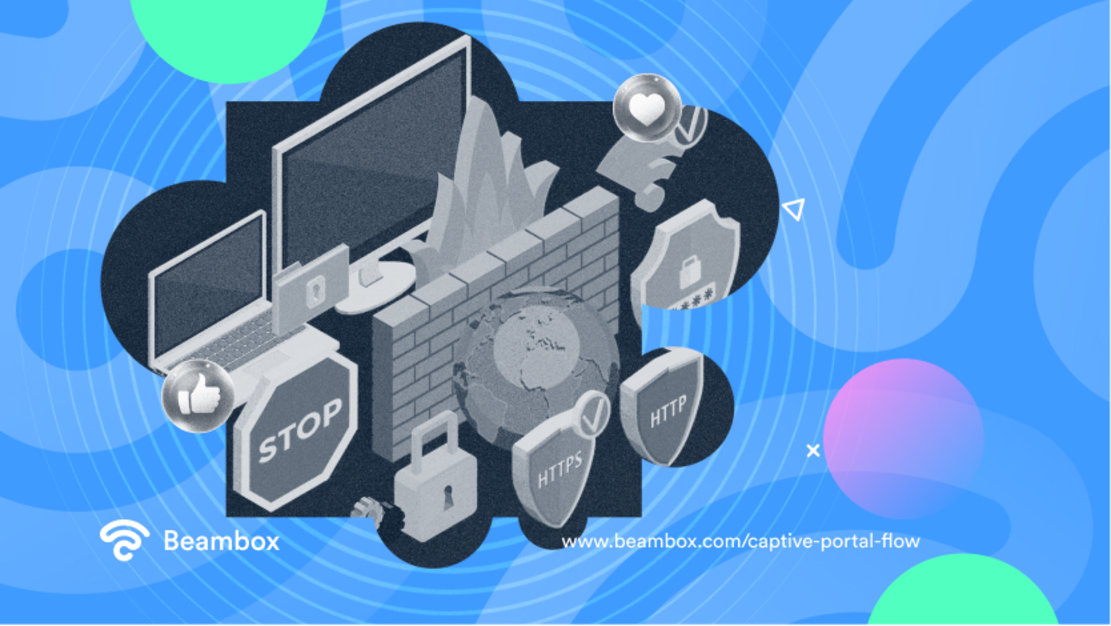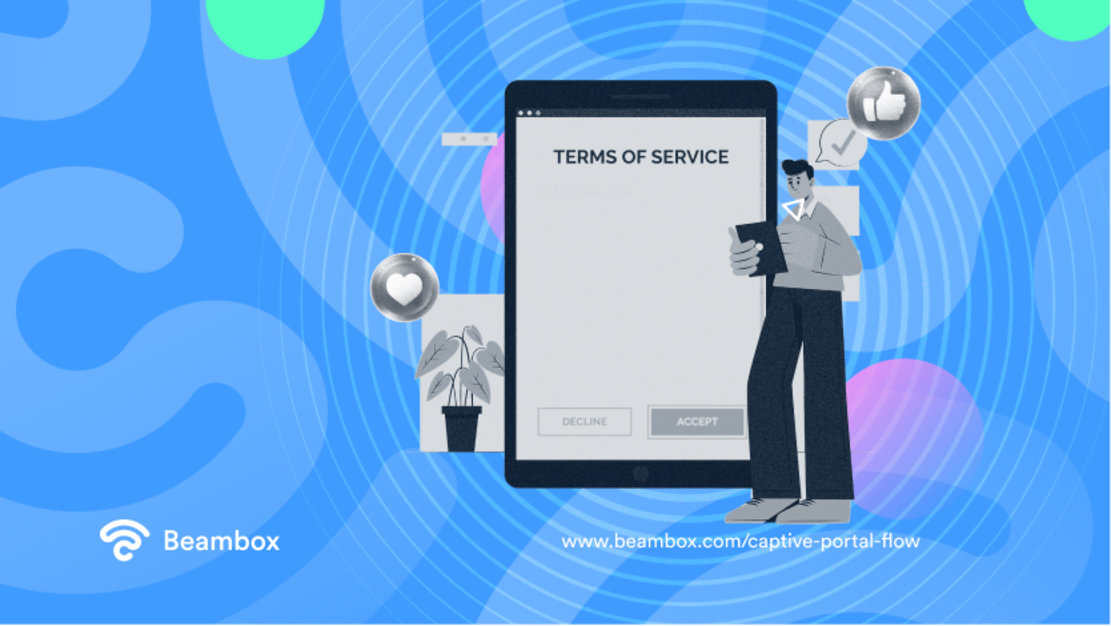Captive Portal Flow: Everything Business Owners Need To Know
As the demand for public WiFi increases, its security risks also increase. Users must pass an authentication process before they can gain access to the internet. This is where a captive portal flow comes into the picture.
Setting up such a process is relatively easy with WiFi marketing software, however, you can do it yourself if you are willing to put in the effort. Let’s start.
What Is Captive Portal Flow?

Captive portal flow is the process users go through when connecting to a WiFi network that requires authentication through a captive portal. Businesses use this web page to authenticate the users trying to access their WiFi network. The flow works in the following simple steps:
- Users connect to the WiFi network and open the web browser.
- The system automatically redirects them to the captive portal login page.
- There, they enter the login credentials or accept the terms of usage.
- The captive portal authenticates the user’s credentials and either grants or denies access to the network.
- The system redirects the users with granted access to the internet.
These steps may depend on the captive portal’s use case and the type of business. But the general flow of a captive portal remains the same regardless of its content.
How Does Captive Portal Flow for Windows 10 Work?
Captive portal flow for Windows 10 provides a layer three authentication. Devices must connect to the network and get an IP address before authenticating. Following are the steps for captive portal flow Windows 10 authentication:
- The device connects to the network and gets a guest role, allowing it to receive an IP address.
- The user opens a web browser and tries to visit a website.
- The device sends a request to a DNS server to find the IP address of the website..
- The DNS server replies with the IP address.
- The browser sends a request to the IP address of the website.
- The network controller intercepts the request. It responds that the website com has temporarily moved to a secure login page on the network controller.
- The browser tries to connect to the secure login page. But first, it needs to send a request to the DNS server to find its IP address.
- The network controller intercepts the DNS request. It responds that the secure login page is at the controller’s IP address.
- The browser connects to the controller’s IP address and shows the captive portal login page. This is where the user can enter their authentication information.
- After successful authentication, the user gets access to the internet.
What Is the Captive Portal Flow Firewall Rule?

To secure your network and avoid unwanted traffic, you can implement specific rules. Captive portal flow firewall rules are a set of network security measures. They control user access to the internet or other network resources. These rules often work in conjunction with a captive portal. Using them in your captive portal flow is crucial to your network’s security.
You can also enforce policies based on MAC addresses. Let’s take the hotel example from above. Suppose one of your guests tries to give access to someone else by sharing a unique username and password. While the login credentials might be the same, the MAC address will differ. This will cause the firewall rule to block unauthorized access.
Firewall rules based on IP addresses are also beneficial. Using these, you can set up a firewall rule to block access to your interconnected file system. They also let you gather an IP address’s browsing data which you can use for future audits.
Firewall rules also allow content filtering. You can block selected websites. For example, a school would block social media websites.
Captive Portal Flow: Why Is This Page Important for the Security of Your Network?
Now that we know how the flow of a captive portal works, let’s discuss its importance. 50% of consumers spend more money on a business if WiFi access is available. With such high stats, it is evident how crucial internet connectivity is for businesses and organizations. But providing open access to your network can pose significant security risks.
One of the best solutions to this problem is a captive portal flow. This is why hotels, airports, and businesses use WiFi hotspots that redirect to custom captive portals. These can provide various security benefits by requiring users to authenticate themselves. Let’s discuss some of its essential benefits in detail.
Captive Portal Flow Benefit #1: Lets You Control Access to Your Network

A captive portal flow helps network administrators control who has access to their network. Due to the risk of network congestion, it may not be desirable to give network access to everyone.
Or you may only want paying customers to access your network. This is especially desirable for the hospitality business. For example, suppose you own a hotel and want to give WiFi access to the people staying at your hotel.
But you also have guests who are just visiting. You can prevent these visitors from gaining access to your guest WiFi network by using a captive portal. Only staying guests with a unique username and password will pass this firewall rule.
Captive Portal Flow Benefit #2: Lets You Collect Insightful User Data
While the primary purpose of a captive portal flow is user authentication, it also helps you collect user data. As your guests enter their personal data you can create customer profiles. This data is important for your marketing strategies.
You can understand your customers’ demographics, interests, and preferences. This enables you to send them personalized offers that encourage their buying decision. Moreover, it helps you increase the effectiveness and efficiency of your marketing.
However, customer privacy is a rising concern. So, it is important to let your customers know what data you will record. You also need to be transparent about how you would use this data.
Captive Portal Flow Benefit #3: Helps Prevent Lawsuits
A captive portal flow can help prevent lawsuits. It does this by enforcing liability compliance and creating a record of user activity on the network. This is why you need to write clear WiFi terms and conditions. Suppose you run a public WiFi network at a coffee shop. You set up a policy that prevents users from downloading copyrighted materials.
You also display a disclaimer that you are not responsible for any illegal activities on the network. The user consents to this policy at the captive portal. Suppose you receive a notice from a copyright holder that someone is downloading copyrighted material from your network.
Using the logs from your captive portal, you can identify the user responsible for this. You can also prove to the copyright holder that you took the necessary steps to enforce policies, preventing a lawsuit.
How Does a Captive Portal Flow Relate to WiFi Marketing?
While a captive portal and WiFi marketing software differ, both can help you grow your business. WiFi marketing uses WiFi access for promotions or to engage with customers. You can design a captive portal flow to display marketing messages when users log in to your WiFi network.
Captive portals require users to enter login credentials such as email addresses, phone numbers, demographic information, etc. You can use this data as a part of your WiFi marketing strategy. Targeted marketing campaigns are the main benefit of this data.
For example, suppose you have set your WiFi session to 2 hours. During this time, you can track the users’ behavior, history, and preferences using WiFi marketing software. After 2 hours, the session expires, and the user has to log in through the captive portal again.
This time, you can display special offers that resonate with the customers’ insights you received during the previous section.
Moreover, surveys and customer feedback are crucial for the success of your business. Captive portals come in handy for this too. You can display a survey form when the session expires and the user logs in again. It may contain questions about their experience at your business. This way, you can monitor the customer experience.
What Are the Best Practices for Using a Captive Portal?

But without following some best practices, your captive portal might not bring these benefits. A thoughtful captive portal flow can do wonders for your business, however, you must pay close attention to how you set it up. Some of the best practices are:
- Display Terms and Conditions: Mention the terms of usage on the captive portal and require the user to consent to them. This can help prevent your business from liabilities and illegal or unauthorized WiFi network use.
- Keep it Simple: Keep your captive portal easy to use and understand. Allow users to quickly navigate through the portal to get online without frustration or confusion. Avoid using multiple pages when possible.
- Be Clear: Provide clear information on what user data you will collect. Also, be transparent about how and where you will use this data. You can display this information at the bottom of the captive portal or in another tab where users can choose to view it.
Should You Customize Your Captive Portal?

While these best practices work wonders for captive portals, customization is also important. Yes, you should customize your captive portal. You can do this easily with the help of WiFi marketing software. You should always use elements of your branding as they will allow users to identify your business and differentiate you from your competitors.
Customization helps you achieve a specific purpose. For example, suppose the default captive portal only has a field for email and password. You can customize it to include a survey or promotional offers.
You can also integrate your social media with customization. With this captive portal flow, you can require users to log in through their social media profiles. Then, you can ask customers to follow you on social media.
Summing up the Importance of Captive Portals and Their Flows
Overall, a captive portal flow allows the proper usage of a WiFi’s captive portal. Working in conjunction with firewall rules, it can help you block unnecessary or unauthorized access.
A captive portal is an extra security layer that protects you and your customers from malicious activity. When combined with WiFi marketing, it can bring you fruitful results.
Do you want to get the most out of your WiFi? With Beambox, you can collect customer data, automate your marketing initiatives, and improve your online reputation. With no additional hardware required and no hidden fees, Beambox is the most affordable and effective solution for small businesses. Start your free trial today!
Get Started With Free WiFi Marketing
Beambox helps businesses like yours grow with data capture, marketing automation and reputation management.
Sign up for 30 days free


